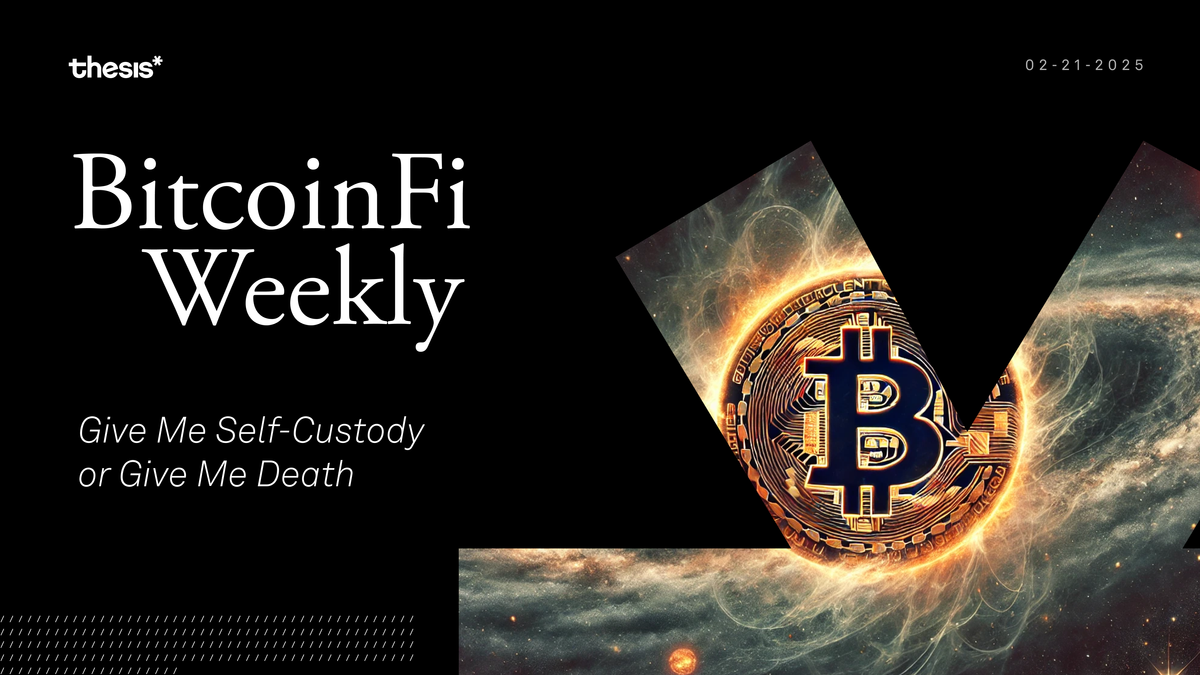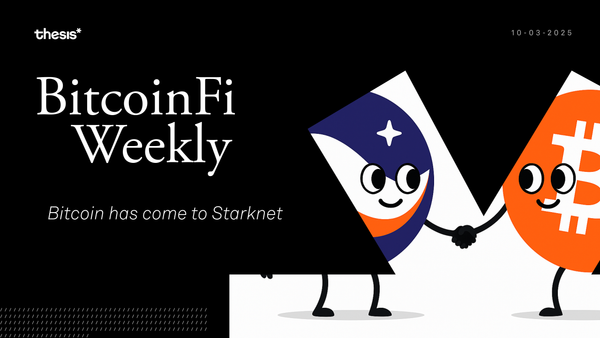Give Me Self-Custody or Give Me Death
Sometimes Bitcoin is digital gold, sometimes it's a hedge, other times it's a black hole that sucks in all the world's monetary energy.

Welcome to BitcoinFi Weekly. We cover where people use their BTC and what is changing in the Bitcoin world.
Bitcoin is a lot of things, depending on who you ask: A store of value, a speculative asset, a revolution, and so on. But here’s another way to think about it: Bitcoin is a machine that turns energy into money. Not the electricity that powers mining rigs, but the collective effort of everyone building tools to move, secure, and use it. This week, we’re looking at how self-custody—the act of holding your own keys—fuels that machine. We'll also check in on some long-term Bitcoin holders who might be done selling for now, peek at what 1,573 institutions are doing with their Bitcoin exposure, examine a v2 of a Bitcoin-native stablecoin, and more. But first, let's talk about energy wells.
Here’s this week’s rundown:
🌊 Feature Piece: Self-Custody Powers Bitcoin’s Energy Well
💎 Are Long Term BTC Holders Done Selling?
🏦 Analyzing Institutions with Long Exposure to Bitcoin
⚖️ Ducat Unveils v2
🎲 Multiparty Contracts for Ark
Feature Piece: Self-Custody Powers Bitcoin’s Energy Well
Sometimes Bitcoin is digital gold, sometimes it's a hedge, other times it's a black hole that sucks in all the world's monetary energy. The fact is, Bitcoin is an evolving network that needs constant energy—both literal electricity for mining and figurative energy from the people building on it. Radu Chichi’s paper, A 3D Thermodynamic Perspective, offers an interesting way to frame this. It argues that Bitcoin takes in real-world resources and turns them into digital scarcity, then channels those units of value around the globe. While the paper is rather technical, I’d like to zoom out and apply its findings to something simple, yet vital. Something like, self-custody.
Chichi’s first pillar, Perfected Digital Energy, posits that Bitcoin’s value derives from irreversible energy expenditure (proof-of-work), anchoring it in physical reality. Self-custodianship ensures this energy remains sovereign. Custodial solutions, by contrast, reintroduce centralized intermediaries—third parties that dilute Bitcoin’s thermodynamic integrity. When users relinquish control, they fracture the link between energy expenditure and ownership, creating entropic leakage. Just as gold’s inertness fails to resolve modern energy gradients, custodianship reintroduces static, trust-based friction, undermining Bitcoin’s role as a dynamic, energy-backed asset.
The Perfected Energy Conduit dimension—Bitcoin’s capacity for frictionless value transfer—further hinges on self-custody. Custodial layers like Liquid or ecash add gateways, throttling the “flow” of digital energy. Lightning Network, despite its early UX flaws, remains the only noncustodial conduit capable of global, instant settlement. In principle, Lightning is a second layer that lets small payments happen rapidly, with the main blockchain serving as a final settlement layer. As Chichi notes, Bitcoin’s programmability and divisibility enable microtransactions and innovation, but only if users retain direct control. Custodianship stifles this by reintroducing permissioned rails, akin to obstructing water’s natural downhill flow.
Here's a fun way to think about Bitcoin custody: When you keep your coins with an exchange or custodian, they exist in a high-energy state. There's risk everywhere. The exchange might get hacked. The CEO might vanish with everyone's money. Regulators might freeze everything. Your coins are nervous and jumpy, filled with potential energy just waiting to become kinetic. But when you move those coins into self-custody, they settle into a lower energy state. They're just sitting there on your hardware wallet or node, peaceful and secure. No counterparty risk, no regulatory uncertainty.
None of this means custodians won’t have a role. There are always people who prefer ease of use. There are always institutions that run big custodial businesses. But from the perspective of this “energy well,” each new self-custodial user or Lightning node operator is another source of security and decentralization. That is the mechanism described by Chichi: the system draws more energy in as more people recognize its utility. Over time, they refine the tools to make it even simpler. Then, new users join, which spurs further improvements, and the loop continues.
If you keep your own keys, you’re playing an active part in that feedback loop. You’re helping shape the network rather than waiting on an app or an exchange to do it for you. This might not feel like a big thermodynamic event. You’re just tapping your phone or copying a seed phrase. But under the hood, you’re aligning with the idea that Bitcoin is more than an inert analogy to gold, as is often described.
BitcoinFi Updates
Are Long Term BTC Holders Done Selling?
According to recent Glassnode data, long-term Bitcoin holder net positions show signs of selling exhaustion. After sustained distribution from October 2024 through January 2025, the rate of long-term holder selling notably decreased in February 2025, suggesting this cohort may have completed their primary wave of profit-taking. The data indicates that significant additional price appreciation may be required to incentivize further substantial selling from long-term holders.
Analyzing Institutions with Long Exposure to Bitcoin
Recent 13F filings indicate that 1,573 institutions reported long exposure to Bitcoin in Q4 2024, spanning hedge funds, banks, pensions, sovereign wealth funds, and endowments. However, 13Fs only show U.S. equity-related holdings—a fraction of most firms’ portfolios. For example, one Abu Dhabi sovereign fund’s 13F listed Bitcoin as its second-largest position (2.1%), but this accounted for just 0.1% of its total $302B portfolio.
The median Bitcoin allocation across filers was 0.13%. Tiny, yes—but notable as a starting point. BlackRock recommends 1-2% allocations, and early adopters are already ahead.
Some firms took a more aggressive stance. Horizon Kinetics maintained Bitcoin as its second-largest position at 16.16% of AUM, while Bracebridge Capital allocated 23.6% to BTC. Other firms with significant exposure include Tudor Investment Corp ($436M, 1.625%), Brevan Howard ($1.4B, 8.74%), and Fortress Investment Group ($70M, 11.2%). State pension funds in Wisconsin and Michigan notably increased their positions, with Wisconsin’s BTC allocation rising from $99M in Q2 to $321M in Q4. Market makers and quant firms such as Millennium, Jane Street, and Citadel also reported large Bitcoin ETF positions, though their involvement is likely driven by liquidity provision and arbitrage rather than directional investment.
Bitcoin has seeped into institutional portfolios, but allocations remain tentative. Escape velocity takes time. For now, the smart money is testing the water—not diving in.
Ducat Unveils v2
Ducat Protocol has launched V2, advancing its overcollateralized stablecoin UNIT, which operates natively on Bitcoin without relying on an intermediary Layer 2. The protocol uses Taproot and Tapscript to enable smart contract-like functionality while preserving Bitcoin’s trust assumptions. UNIT remains backed by BTC at over 160% collateralization.
The V2 upgrade introduces Frost Threshold Signature technology, enhancing decentralized security, scalability, and user flexibility. A new Transaction Tracker Telegram Bot provides real-time transaction insights, and support for Unisat users has been added. Ducat will maintain support for V1 in legacy mode, allowing withdrawals but preventing new UNIT minting. Other key updates include expanded MPC network documentation, detailed CRSs (Canonical Reference Satoshis) insights, and liquidation incentive refinements. For more, check out their documentation.
Multiparty Contracts for Ark
Ark Labs has introduced Coinflip PoC, a proof-of-concept demonstrating trust-minimized multiparty contracts on Ark. The project explores how Bitcoin Script can be used to facilitate complex smart contract flows despite its limited expressiveness. Coinflip utilizes off-chain validation by Ark operators, ensuring that in the optimistic case, transaction logic does not need to be executed on-chain. This approach reduces onchain congestion while maintaining a trustless environment. Ark’s architecture, built around presigned transactions, coordinates multiparty interactions efficiently, and Nostr serves as the real-time communication layer.
Coinflip implements a three-step transaction structure where two players engage in a heads-or-tails game using predetermined secret generation. The setup transaction commits Player A’s secret, the final transaction enforces Player B’s reveal and validation, and the cashout transaction allows the winner to claim funds. The protocol's design uses secret generation of predetermined sizes (15 bytes for "Heads" and 16 bytes for "Tails") to emulate the coin flip, with the game's outcome determined through a sequence of revealing secrets and executing presigned transactions. These early experiments highlight Ark’s expanding use case of trust-minimized applications on Bitcoin.
Closing Thoughts
And so, in the end, what is Bitcoin if not a great and tireless force, set into motion by the will of people who do not yet understand the gravity of their own creation? They gather around it, hesitant and awed, sensing in its ceaseless transformation something vast, something inevitable. To hold one’s coins in custody is to stand at the precipice, gazing into the abyss of trust, where entropy gnaws at the edges of promises. Yet in self-custody, there is a quietude, a surrender to Bitcoin’s inexorable pull—a submission not to man or institution, but to the cold logic of thermodynamics itself.
Thank you for tuning in to this week’s BitcoinFi Weekly. See you next week.
If there's a topic you’d like us to cover or have questions, reach out at [email protected].





